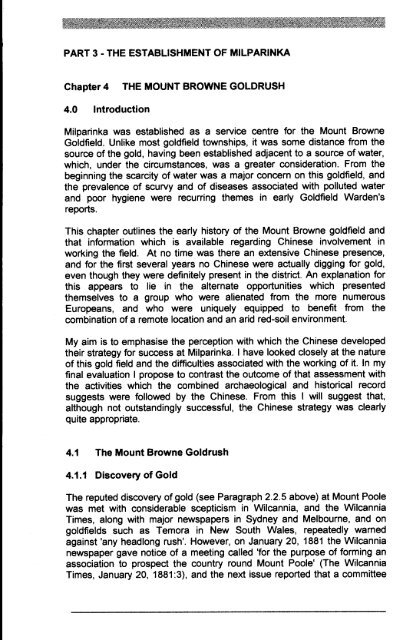Adec Preview Generated PDF File - The Sydney eScholarship ...
Adec Preview Generated PDF File - The Sydney eScholarship ...
Adec Preview Generated PDF File - The Sydney eScholarship ...
You also want an ePaper? Increase the reach of your titles
YUMPU automatically turns print PDFs into web optimized ePapers that Google loves.
PART 3 - THE ESTABLISHMENT OF MILPARINKA<br />
Chapter 4 THE MOUNT BROWNE GOLDRUSH<br />
4.0 Introduction<br />
Milparinka was established as a service centre for the Mount Browne<br />
Goldfield. Unlike most goldfield townships, it was some distance from the<br />
source of the gold, having been established adjacent to a source of water,<br />
which, under the circumstances, was a greater consideration. From the<br />
beginning the scarcity of water was a major concern on this goldfield, and<br />
the prevalence of scurvy and of diseases associated with polluted water<br />
and poor hygiene were recurring themes in early Goldfield Warden's<br />
reports.<br />
This chapter outlines the early history of the Mount Browne goldfield and<br />
that information which is available regarding Chinese involvement in<br />
working the field. At no time was there an extensive Chinese presence,<br />
and for the first several years no Chinese were actually digging for gold,<br />
even though they were definitely present in the district. An explanation for<br />
this appears to lie in the alternate opportunities which presented<br />
themselves to a group who were alienated from the more numerous<br />
Europeans, and who were uniquely equipped to benefit from the<br />
combination of a remote location and an arid red-soil environment.<br />
My aim is to emphasise the perception with which the Chinese developed<br />
their strategy for success at Milparinka. I have looked closely at the nature<br />
of this gold field and the difficulties associated with the working of it. In my<br />
final evaluation I propose to contrast the outcome of that assessment with<br />
the activities which the combined archaeological and historical record<br />
suggests were followed by the Chinese. From this I will suggest that,<br />
although not outstandingly successful, the Chinese strategy was clearly<br />
quite appropriate.<br />
4.1 <strong>The</strong> Mount Browne Goldrush<br />
4.1.1 Discovery of Gold<br />
<strong>The</strong> reputed discovery of gold (see Paragraph 2.2.5 above) at Mount Poole<br />
was met with considerable scepticism in Wilcannia, and the Wilcannia<br />
Times, along with major newspapers in <strong>Sydney</strong> and Melbourne, and on<br />
goldfields such as Temora in New South Wales, repeatedly warned<br />
against 'any headlong rush'. However, on January 20, 1881 the Wilcannia<br />
newspaper gave notice of a meeting called 'for the purpose of forming an<br />
association to prospect the country round Mount Poole' (<strong>The</strong> Wilcannia<br />
Times, January 20, 1881 :3), and the next issue reported that a committee




